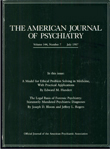Handbooks that medical students, residents, and other clinicians can use for a handy reference for psychopharmacological treatment are exceptionally useful if they are updated so that the information is current, accurate so that what is contained is reasonable, and balanced so that each compound is given a fair shake.
The seventh edition of the Psychotropic Drug Handbook meets all of these criteria. In addition, it is relatively compact and thus easy to carry along and refer to on the spot. The sixth edition was published in 1991; the preface of this edition indicates what changes have occurred since then. These include the addition of antipsychotic medications such as risperidone, olanzapine, and sertindole; antidepressants such as sertraline, paroxetine, venlafaxine, nefazodone, and mirtazapine; the hypnotic zolpidem; and a discussion of fluvoxamine for obsessive-compulsive disorder.
I like the layout of this handbook, which, generally, is a division by drug classification (antidepressant, antimanic, antianxiety, hypnotic, and agents for treating extrapyramidal side effects). In addition, there are separate chapters for treatment of alcohol and drug dependence, a discussion of drug interactions, management and treatment of drug overdose, management of withdrawal syndromes, therapy, and ECT. There is also a patient advice chapter with what amounts to tear-out sheets for each of the medications in common use. The clinician could get copies of the tear-out sheets and add information to make them more personal and yet have the drug information for patients available.
Each medication chapter is divided into subtypes of what drugs are available in that class, their indications, efficacy, mechanism of action, dosage, pharmacokinetics, adverse events, and, finally, “rational prescribing.” This final section is an overview discussing all of the medications in that particular class and providing some practical pointers regarding how to do prescribe them.
There is also a very nice reference list, and the references are through 1996, which is very up-to-date in view of the fact that this book has a 1997 publishing date. There is also very useful index so that one can look up a topic such as sexual dysfunction or a drug such as lithium and find information about these topics rather quickly.
This is a very handy and appropriately sized pocket handbook. It is current and user-friendly and gives very good advice and pointers to the clinician. One of the down sides to this particular volume is the lack of favoritism. I would prefer that some medications be listed with discouragement regarding their use because they have been replaced by more appropriate and safer medications. However, negative reactions are certainly listed for medications associated with seizures or peculiar side effects.
This book would be very handy and useful for medical students and psychiatry residents. Other individuals in the mental health field who are nonprescribers may find its ease of use appealing when they want to know something about the medications that are being given to patients they are treating with psychotherapy. Experienced clinicians involved in psychopharmacology may have some use for this volume. It presents a balanced point of view, and the referencing is quite extensive.

